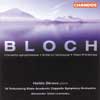Bloch Works for Piano and Orchestra
Fine performances of entertaining but largely insubstantial music
View record and artist detailsRecord and Artist Details
Composer or Director: Ernest Bloch
Genre:
Orchestral
Label: Chandos
Magazine Review Date: 9/2003
Media Format: CD or Download
Media Runtime: 62
Mastering:
Stereo
DDD
Catalogue Number: CHAN10085

Tracks:
| Composition | Artist Credit |
|---|---|
| Hiver-Printemps |
Ernest Bloch, Composer
Alexander Tchernushenko, Conductor Ernest Bloch, Composer St Petersburg State Academic Capella Symphony Orchestra |
| Scherzo Fantasque |
Ernest Bloch, Composer
Alexander Tchernushenko, Conductor Ernest Bloch, Composer Halida Dinova, Piano St Petersburg State Academic Capella Symphony Orchestra |
| Concerto Symphonique |
Ernest Bloch, Composer
Alexander Tchernushenko, Conductor Ernest Bloch, Composer Halida Dinova, Piano St Petersburg State Academic Capella Symphony Orchestra |
Author: Ivan March
The 1947/8 Concerto symphonique is a comparatively late work and, although in only three movements, is cast somewhat in the mould of the Brahms B flat major Concerto, with the powerful piano role having something of an obbligato character. The work is unified by a bold, upward rising figure heard at the opening, but the music soon moves into a trenchant march theme which inevitably suggests a symbolic Exodus-like processional.
The material is strongly if rhapsodically developed, but the movment ends sombrely rather than triumphantly. The second movement is – as with Brahms – a scherzo, which the Bloch suggested is macabre in character, but it is an ironic diabolism and (in the absence of a true slow movement) introduces a nostalgically lyrical inner core of some intensity. The return of the scherzo is sardonic rather than sinister, with brilliant roulades from the piano effectively vying with bizarre interjections from the brass. Yet again the music’s energy subsides as the movement closes in a curious pleading acquiescence.
The finale opens with a boisterous fanfare, but slips into lyricism, before setting off confidently into its resolution, a good-humoured, emphatically martial toccata, with a bell-like secondary theme from the piano. Halida Dinova plays it with conviction and panache, and has equally vigorous and spirited support from the St Petersburg players under Tchernushenko.
They are almost as persuasive in the rumbustious Scherzo fantastique, which followed the Concerto in 1948, but really has nothing new to say. The two symphonic poems are eclectically youthful works of considerable appeal, the first an idyll, the second gentle, dance-like scherzando, with an endearing melody; both are comparatively tranquil and engagingly scored. They are beautifully played, but in the end, like the concertante works, these fine performance and the full-bodied, expansive Chandos sound, cannot convince one that while this is all enjoyable music, it is unsurprising that it is not heard more often in the concert hall.
The material is strongly if rhapsodically developed, but the movment ends sombrely rather than triumphantly. The second movement is – as with Brahms – a scherzo, which the Bloch suggested is macabre in character, but it is an ironic diabolism and (in the absence of a true slow movement) introduces a nostalgically lyrical inner core of some intensity. The return of the scherzo is sardonic rather than sinister, with brilliant roulades from the piano effectively vying with bizarre interjections from the brass. Yet again the music’s energy subsides as the movement closes in a curious pleading acquiescence.
The finale opens with a boisterous fanfare, but slips into lyricism, before setting off confidently into its resolution, a good-humoured, emphatically martial toccata, with a bell-like secondary theme from the piano. Halida Dinova plays it with conviction and panache, and has equally vigorous and spirited support from the St Petersburg players under Tchernushenko.
They are almost as persuasive in the rumbustious Scherzo fantastique, which followed the Concerto in 1948, but really has nothing new to say. The two symphonic poems are eclectically youthful works of considerable appeal, the first an idyll, the second gentle, dance-like scherzando, with an endearing melody; both are comparatively tranquil and engagingly scored. They are beautifully played, but in the end, like the concertante works, these fine performance and the full-bodied, expansive Chandos sound, cannot convince one that while this is all enjoyable music, it is unsurprising that it is not heard more often in the concert hall.
Discover the world's largest classical music catalogue with Presto Music.

Gramophone Digital Club
- Digital Edition
- Digital Archive
- Reviews Database
- Full website access
From £8.75 / month
Subscribe
Gramophone Full Club
- Print Edition
- Digital Edition
- Digital Archive
- Reviews Database
- Full website access
From £11.00 / month
Subscribe
If you are a library, university or other organisation that would be interested in an institutional subscription to Gramophone please click here for further information.




